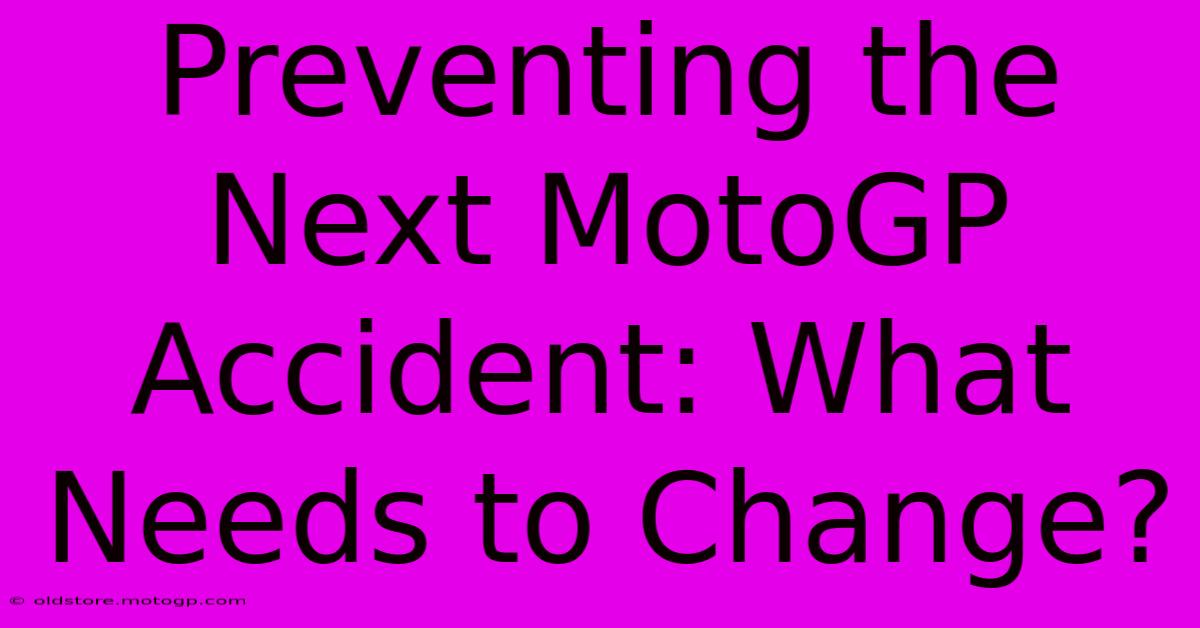Preventing The Next MotoGP Accident: What Needs To Change?

Table of Contents
Preventing the Next MotoGP Accident: What Needs to Change?
The recent spate of high-profile accidents in MotoGP has cast a shadow over the sport, leaving fans, riders, and organizers alike questioning what needs to be done to improve safety. While inherent risk is part of motorcycle racing, the frequency and severity of some crashes demand a serious reassessment of current safety protocols and track designs. This article delves into the crucial areas needing attention to prevent future tragedies.
Analyzing the Causes: A Multi-Faceted Problem
Accidents in MotoGP are rarely attributable to a single cause. Instead, they often stem from a complex interplay of factors, including:
1. Track Design and Safety Features:
- Run-off areas: Inadequate run-off areas, especially those ending abruptly with barriers, contribute significantly to high-impact crashes. Wider, smoother run-off zones with strategically placed Tecpro barriers could mitigate the severity of impacts.
- Track layout: Blind corners and excessively fast sections, combined with limited visibility, increase the risk of accidents. Modifying track layouts to improve visibility and reduce corner speeds could significantly enhance safety.
- Barrier types and placement: The type and placement of barriers play a crucial role. The transition from asphalt to gravel traps can be treacherous, causing bikes to lose control. Consistent, safer barrier types across all tracks need to be considered.
2. Rider Skill and Training:
- Increased focus on safety training: While MotoGP riders are highly skilled professionals, continuous improvement in safety training and rider education is necessary. Simulators and advanced training programs could help prepare riders for challenging conditions and unexpected events.
- Data analysis and rider feedback: Comprehensive data analysis of past accidents, combined with feedback from riders, could identify recurring patterns and highlight areas needing improvement in rider skills and techniques.
3. Motorcycle Technology and Safety Innovations:
- Airbag technology: Further advancements in airbag technology could minimize injuries from impacts. Improved deployment mechanisms and more comprehensive coverage are vital.
- Improved chassis design: Innovations in chassis design and tire technology could enhance stability and improve traction, reducing the risk of accidents caused by sudden loss of control.
- Motorcycle data logging: Real-time data logging from each motorcycle could provide valuable information regarding the dynamics of an accident, assisting in the identification of potential safety issues.
4. Race Direction and Regulation:
- Race management: Effective race management during wet or challenging conditions is crucial. Clear communication with riders and timely decisions regarding red flags or race suspensions are paramount.
- Consistent enforcement of regulations: Stringent enforcement of safety regulations and penalties for unsafe riding could discourage risky behavior and improve overall safety.
- Improved medical response: Ensuring readily available and highly skilled medical personnel at every track with quick emergency response protocols is absolutely essential.
Proactive Measures for a Safer Future
Moving forward, a collaborative approach involving track designers, race organizers, teams, riders, and governing bodies is crucial. This involves:
- Independent safety audits: Regular, independent safety audits of all MotoGP circuits to identify and address potential hazards.
- Increased investment in safety research: Dedicated funding for research and development of advanced safety technologies and protocols.
- Open communication and data sharing: Fostering open communication and data sharing among all stakeholders to facilitate learning from past accidents and prevent future ones.
- Continuous improvement cycle: Implementing a continuous improvement cycle where safety is prioritized, and modifications are based on data and feedback.
Conclusion:
Preventing future MotoGP accidents requires a holistic approach focusing on track design, rider skill, motorcycle technology, and race management. By proactively addressing these key areas, MotoGP can ensure the continued thrill and excitement of the sport while simultaneously prioritizing the safety of its riders. The future of MotoGP depends on it.

Thank you for visiting our website wich cover about Preventing The Next MotoGP Accident: What Needs To Change?. We hope the information provided has been useful to you. Feel free to contact us if you have any questions or need further assistance. See you next time and dont miss to bookmark.
Featured Posts
-
F1 Austin Explore The City Beyond The Track
Feb 25, 2025
-
Conquer Cota Parking The Easy Way
Feb 25, 2025
-
A Day Of Glory Who Won The Grand Prix Yesterday
Feb 25, 2025
-
Get Ready To Rumble Moto Gp Racing Time Is Back
Feb 25, 2025
-
Unleash Your Racing Spirit Bikes Await
Feb 25, 2025
